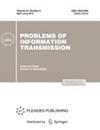具有最佳双向距离剖面的卷积码
IF 0.9
4区 计算机科学
Q4 COMPUTER SCIENCE, THEORY & METHODS
引用次数: 0
摘要
摘要 我们将卷积码的双向距离轮廓(BDP)定义为该码及其相应 "反向 "码的距离轮廓的最小值。我们提出了具有最佳 BDP(OBDP)的编码表,这些编码能使双向顺序解码算法的平均复杂度最小化。较大内存的最优距离轮廓(ODP)编码必须有较小内存的 ODP 编码作为其 "前缀",而 OBDP 编码可以通过 "串联 "较小内存的 ODP 和反向 ODP 编码来获得,这些事实加快了计算机搜索的速度。我们通过仿真比较了 OBDP 代码和其他代码的性能。本文章由计算机程序翻译,如有差异,请以英文原文为准。
Convolutional Codes with Optimum Bidirectional Distance Profile
Abstract
We define the bidirectional distance profile (BDP) of a convolutional code as the minimum of the distance profiles of the code and its corresponding “reverse” code. We present tables of codes with the optimum BDP (OBDP), which minimize the average complexity of bidirectional sequential decoding algorithms. The computer search is accelerated by the facts that optimum distance profile (ODP) codes of larger memory must have ODP codes of smaller memory as their “prefixes”, and that OBDP codes can be obtained by “concatenating” ODP and reverse ODP codes of smaller memory. We compare the performance of OBDP codes and other codes by simulation.
求助全文
通过发布文献求助,成功后即可免费获取论文全文。
去求助
来源期刊

Problems of Information Transmission
工程技术-计算机:理论方法
CiteScore
2.00
自引率
25.00%
发文量
10
审稿时长
>12 weeks
期刊介绍:
Problems of Information Transmission is of interest to researcher in all fields concerned with the research and development of communication systems. This quarterly journal features coverage of statistical information theory; coding theory and techniques; noisy channels; error detection and correction; signal detection, extraction, and analysis; analysis of communication networks; optimal processing and routing; the theory of random processes; and bionics.
 求助内容:
求助内容: 应助结果提醒方式:
应助结果提醒方式:


